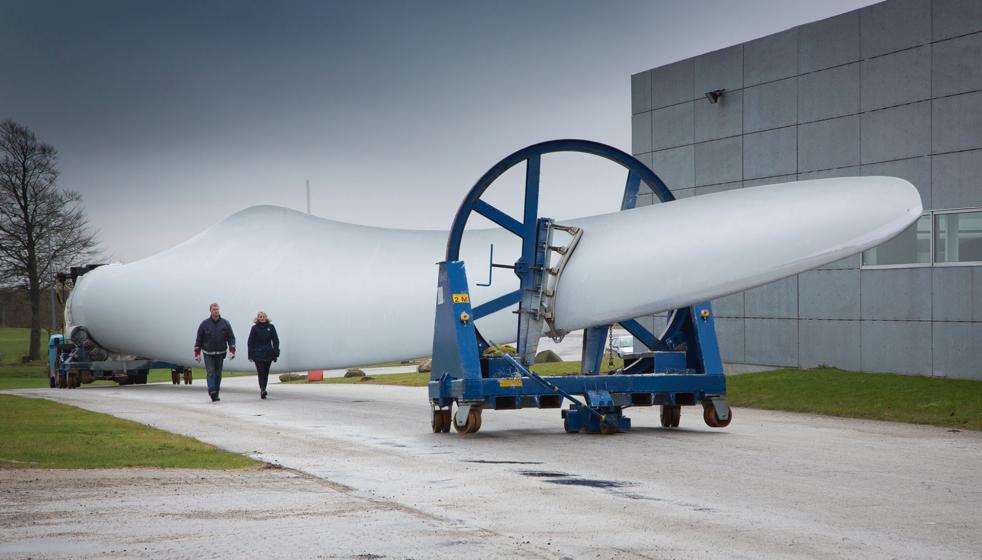If the renewables tsunami starting to slam into the traditional energy business feels like it's growing larger, there's a perfectly logical reason. As the world’s longest offshore wind turbine blade was rolling off a factory floor last week in Denmark, Bloomberg New Energy Finance (BNEF) released a report saying that renewables will swamp the once predictable "ever-growing demand" of fossil fuels and leave them underwater in less than a decade.
That bold prediction, a trademark of Bloomberg's annual, long-term forecast, jumped out of this year's New Energy Outlook 2016. Chock full of explanatory charts and graphs (most behind a paywall), it shows a steep decline in wind and solar costs pushing the electricity system toward renewables (read the executive summary).
For proof look no further than the Danish builder of the 180-meter wind turbine blade, LM Wind Power, whose engineering team has continued to push down the blade's levelized cost of energy (LCoE). Ultimately, looking through BNEF's prism, innovation over the next fifteen years will cause $7.8 trillion globally invested in renewables to make up a lopsided two-thirds of new power generation.

Companies like LM Wind Power have made the whole industry increasingly competitive in onshore markets, while putting offshore wind within competitive reach.
BNEF thinks that by 2027 something remarkable will happen: at that point, building new wind farms and solar fields will often be cheaper than running existing coal and gas generators. The report says, "This is a tipping point that results in rapid and widespread renewables development."
Shutting off natural gas
So even though cheap natural gas has been the dominant force in US power markets for the last six years, ravaging the now bankrupt coal industry, rock-bottom fuel prices won't derail a rapid global transition toward renewable energy.
"The economics are increasingly locked in," said Seb Henbest, BNEF's lead author. He pegs the peak year for coal, gas, and oil at 2025.
The renewables onslaught will pick up momentum as the cost of onshore wind drops 41% by 2040, driven primarily by improving capacity factors that are projected to reach 33% in 2030 and 41% in 2040.
At a perfectly timed photo-op, last week DONG Energy announced that it will build a new 450 MW offshore wind farm in the North Sea, called Borkum Riffgrund 2. Deploying just 56 MHI Vestas 8 MW turbines, the project will generate enough electricity to power approximately 460,000 German households.
Turbines have rapidly grown so efficient since DONG received consent to build Borkum Riffgrund in 2011, that the developer had to amend its agreement to install the newer 8 MW turbines.
Samuel Leupold, DONG Energy's head of wind power, said: "The 8MW turbine takes offshore wind efficiency a step forward." And once Borkum 2 is commissioned, DONG will have a massive 6.7GW of offshore wind capacity under operation.
Optimism about renewables in general and DONG specifically has spread to the stock market. Last week the wind developer went public in Europe's largest IPO of 2016. Shares sold at above the guidance, valuing the company at more than $15 billion.
Highlighting DONG's debut, the European offshore wind industry told Greentech Media, "With the right build-out and regulatory framework, offshore wind will be fully competitive with new conventional power within a decade."
Plunging solar costs
When BNEF looks at solar, they see a similar drop in costs pushing new utility-scale solar down 60% from today, to around $40/MWh worldwide in 2040.
Somewhere around 2030, solar will emerge as the least-cost energy technology in most countries. It will grab 3.7TW or 43% of new power capacity, with over $3 trillion invested through 2040.
Some of these gains are already a reality. This week a Masdar-led group won an auction to build a solar-power plant in Dubai. It will produce the world’s cheapest solar power to date, once the 800-MW project is completed in 2020.
Dubai, which is adding solar to diversify its energy mix, dropped costs by switching from a feed-in-tariff (FIT) to an auction system like many other developing countries and squeezed out a winning bid for 2.99 cents per kilowatt-hour, DEWA Chief Executive Officer Saeed Mohammed Al Tayer said.
“This project has set a benchmark,” Saji Sam, a partner at consultants Oliver Wyman, told Bloomberg.
It's important to note that this bid beats the cost of power generated from coal; and it’s already 15 percent lower than the old solar power record set in Mexico in April.
Retiring coal plants
As new wind and solar capacity is added worldwide, generation is predicted to rise 900 percent to 10,591 TWh by 2040, or 30% of the global total. By 2040, Germany, Mexico, the UK and Australia all are expected to have wind and solar penetration of more than 50%.
With the rise of renewables comes a fall in the capacity of coal and gas plants. This trend is expected to contribute to the retirement of 819GW of coal and 691GW of gas worldwide over the next 25 years.
The remaining fossil plants will be used to help meet peak demand, while also ramping up when solar comes offline each evening.
Rooftop solar scales up
Overall, solar PV will supply 15% of world electricity by 2040, with an average $135bn invested each year for the next 25 years.
The bulk of solar will be utility-scale, starting in China, Europe, and the US, and accelerating in Africa and India by 2025.
But households and businesses will add solar PV on rooftops to offset retail power bills everywhere. This trend is predicted to start with Europe, Australia and the US but will quickly spread to India and other developing countries.


